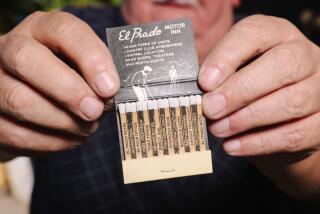Radio Enthusiasts Tune to Rare Models of the ‘20s
- Share via
Question: I have an old Emerson radio and would like some information on its history and value. What sources would you recommend to provide me with some background on old radios?--N.T.
Answer: Contact the Southern California Antique Radio Society (SCARS), which has more than 650 members who take a deep interest in the history of early radio manufacturers.
The group’s quarterly publication is called the California Antique Radio Gazette and is included in its yearly dues of $10 ($11 for member and spouse). Inquiries should be addressed to SCARS incoming president, Walter Curry, 10035 Country View Road, La Mesa, Calif. 92041.
Outgoing president Mike Adams said SCARS is the largest radio collectors club west of the Mississippi. (The biggest national organization, he said, is the Antique Wireless Assn., a 3,000-member group based near Rochester, N.Y.)
Adams, 45, who just moved to the San Jose area where he teaches a college course in radio and television production, said “the best way” to become a serious radio collector is “to join SCARS.”
The group, he said, sponsors four local swap meets a year--in February, May, August and November. “This is when you meet the largest collection of radio people on the West Coast,” Adams said in a recent telephone interview.
Adams personally has more than 200 old radios in his collection. Among the most sought-after collectible radios, he said, are:
--The Philco Model 90 “cathedral” radio, so-called because of its shape. It was produced in the early 1930s and can sell now for about $500, depending on condition.
--The Atwater Kent “breadboard” radio, so-called because all of its parts--tubes and all--were exposed and literally nailed to an attractive oak breadboard. It was manufactured in the middle 1920s and can sell now for up to $600.
--Catalin radios, so-called because of the brightly colored plastic shells in which they were encased. The design was used by a number of radio manufacturers in the 1930s and 1940s. Currently, catalin-designed radios have attracted great interest among collectors and decorators and, as a result, have rocketed in value, selling for $1,000 or more.
--Sparton blue-mirrored radios, literally enclosed inside a cabinet of mirrors. This rare Art Deco masterpiece, manufactured in the 1930s, has changed collectors’ hands for as much as $15,000, Adams said.
In terms of judging its collectible price tag, Adams said that “a radio doesn’t have to be restored to playing condition to have value.” But a collectible radio’s physical condition, he said, does have to be near perfect in terms of original parts.
Finding such radios, however, is not always an easy task because most collectors want models produced in radio’s Golden Age--the 1920s.
Floyd A. Paul, co-editor of the SCARS quarterly, has produced a new book on the subject: “Los Angeles Radio Manufacturing: The First Twenty Years (1922-1942).”
The 88-page, illustrated book has an index and provides a fascinating look at the start of the electronic industry in Southern California, including the old radio firms that were an important part of this history.
Paul traces, with an eye for detail and local color, the histories of Advance Electric, DeForest, Echophone, Gilfillan, Horn, Jackson-Bell, Packard-Bell, Patterson, Pierson-DeLane, Powell, Sheldon and Troy.
It is available for $12 (includes postage, shipping and tax) through Floyd A. Paul, 1545 Raymond Ave., Glendale, Calif. 91201.
Soble cannot answer mail personally but will respond in this column to questions of general interest about collectibles. Do not telephone. Write to Your Collectibles, You section, The Times, Times Mirror Square, Los Angeles 90053.
More to Read
Sign up for The Wild
We’ll help you find the best places to hike, bike and run, as well as the perfect silent spots for meditation and yoga.
You may occasionally receive promotional content from the Los Angeles Times.






